Corporate innovation programs are systems designed to capture innovative ideas and develop them into solutions that drive business growth.
By employing an effective corporate innovation program, companies can continuously improve their existing offerings to align with evolving customer expectations and needs, as well as competitor developments. They also protect themselves from disruption by exploring startup partnerships, new technologies, and emerging markets.
That said, we've found that many companies make some critical mistakes when setting up innovation management programs, preventing them from delivering meaningful value. For example:
They don’t clarify their priorities to employees and don’t update them when priorities change. Employees often submit ideas that are later deemed irrelevant, and companies reject most of them.
They don’t put ideas through a refinement step where everyone inside the company, with different skill sets, can review them and make improvements. This leaves them with low-quality ideas.
They don’t set up the required systems and structures to develop ideas into beneficial products, services, processes, and continuous improvements. The corporate innovation program doesn’t drive business growth.
They fund validation projects from the outset, which causes innovation teams to run elaborate experiments instead of the most cost-effective ones, limiting the number of ideas companies can pursue.
To help companies avoid these mistakes, we've put together this guide detailing the approach we've used over the last 10+ years as innovation consultants to set up corporate intrapreneurship programs that generate a return on investment (ROI).
We also touch on how our innovation management software, InnovationCast, supports this approach and helps companies manage innovation at scale.
Schedule a quick demo to see how InnovationCast can help you launch a corporate innovation program in under four weeks.
Steps for Implementing an Effective Corporate Innovation Program
Regardless of the type of innovation program, whether you’re sourcing insights from startups, employees, or customers, it will usually contain the following steps:
Idea generation: Companies should encourage employees to think like entrepreneurs by inviting them to share ideas that address corporate initiatives and priorities. Properly executing this helps foster an intrapreneurial mindset because employees know the company wants their ideas and is willing to fund them if they’re good enough.
Refinement: For internal innovation, companies should make ideas available to all participants so they can co-create to improve them.
Evaluation and prioritization: Subject matter experts should evaluate ideas by scoring them against pre-defined criteria and prioritize the most impactful, urgent, and promising ones.
Validation and incubation: The team responsible for the idea should validate that it’s worth implementing. This involves defining what hypothesis must be true for the idea to work (this may relate to user demand, profitability, feasibility, etc.) and running experiments to test those hypotheses.
Implementation: Teams that validate hypotheses should have their ideas developed into full-scale solutions. Then, companies should monitor customer metrics and feedback and use them to continuously improve the innovation.
1. Idea Generation
Companies typically kickstart an innovation program by asking employees and outside innovation participants to share ideas. This leverages the thinking power and competencies of potentially hundreds of subject matter experts to brainstorm solutions.
While we welcome this crowdsourcing approach, the method you use to crowdsource ideas plays a fundamental part in the success of your corporate innovation and internal entrepreneurship program.
Many companies make the mistake of setting up an open call for ideas without providing participants with context on the types of ideas they're looking for.
Since participants don’t know the company’s priorities, they share irrelevant and sometimes random ideas. Companies dismiss the majority of ideas, resulting in frustration and significant time waste for all parties.
Instead, we advise companies to clarify their core focus areas, communicate these focus areas to participants (preferably in document form so they can easily refer back to them), and ask them to exclusively share relevant ideas. This focuses the competencies and perspectives of all participants on a couple of key priorities.
A great way to do this is by running Innovation Challenges or hackathons, which are campaigns containing information on specific priorities and a submission link where participants can submit their ideas.
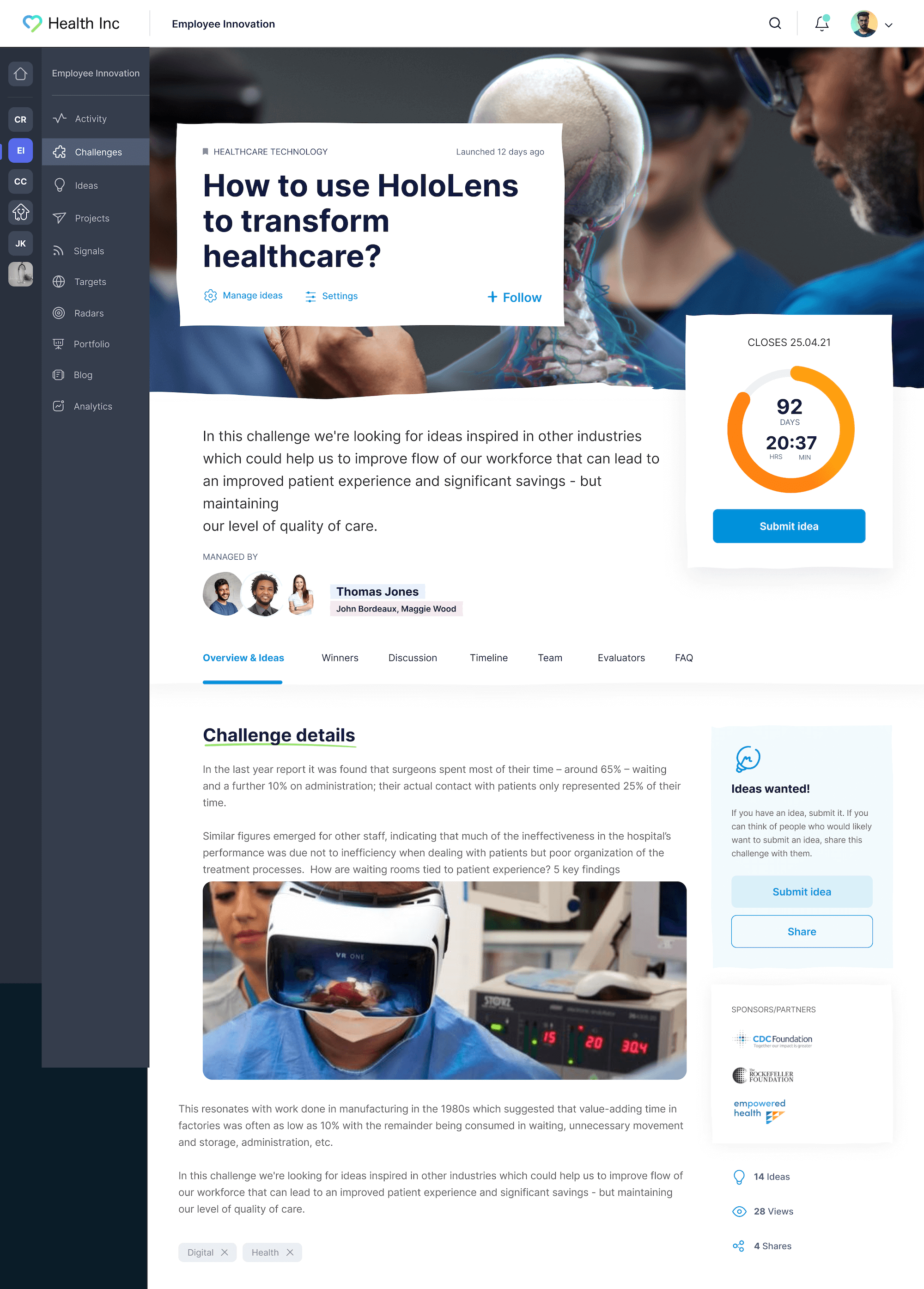
Innovation Challenges offer three advantages over regular open calls for ideas:
More relevant ideas: By focusing participants on specific topics and themes, Innovation Challenges captures ideas that directly address key business objectives.
Higher quality ideas: The context provided by clear problem statements encourages participants to be specific in their submissions rather than sharing generic, hype-driven solutions.
Higher quantity of ideas: The time-sensitive nature of Innovation Challenges, with defined deadlines, motivates participants to act quickly and submit their ideas, resulting in a larger volume of solutions within a shorter time frame.
Side note: We’d like to stress the importance of external or open innovation, i.e., looking outside the company for ideas. Companies rarely have internal personnel to solve all priorities, so we recommend going beyond the company walls for ideas. This means involving startups, academic institutions, researchers, etc., in problem-solving initiatives.
Read more: 5 Detailed Innovation Challenge Examples & Best Practices
Use InnovationCast to Publish Innovation Challenges & Centralize Ideas
Companies usually launch Innovation Challenges by creating a Google Doc and asking employees to study the information inside and share ideas via a Google Form link. They then attempt to manage all ideas within a basic spreadsheet. If departments want to pursue ideas, they must export them into separate, ad hoc tools.
This fragmented process leaves information scattered across platforms — email threads, Google Drive, task management software, Zoom calls, and even physical notes. Nobody pursues ideas because it’s a logistical nightmare to do so.
We designed our innovation management software, InnovationCast, to enable companies to easily manage hundreds of ideas.
Companies can publish an Innovation Challenge, and we notify all relevant participants to read the announcement and submit ideas. Once participants submit their ideas, companies can manage them within their InnovationCast dashboard. (More on this below.)
Participants can see the stages their idea will go through before implementation. They can see who’s responsible for evaluating their idea, how it’s faring, and the budget it’ll receive once approved.
Media shared between evaluators, idea authors, innovation leaders, and other relevant persons is centralized within the idea thread for quick access.
Read more: How to Implement an Effective Idea Generation Process in Your Organization
2. Idea Refinement
In most corporate innovation and accelerator programs, ideas are immediately sent for evaluation, where they’re either approved for implementation or cut loose.
However, we don't recommend sending ideas for evaluation immediately after they're submitted. Most ideas have shortcomings that the author may not have considered while formulating them. This is natural because ideas require examination from different perspectives: technical aspects, design, marketing, IT, logistics, etc. An idea author alone doesn’t have the full range of skills needed to evaluate their idea from every perspective.
To improve the quality of ideas, we suggest incorporating a step for idea improvement. In this step, participants from different backgrounds view the idea and offer their expertise to the author. Companies that implement this successfully strengthen ideas with the shared intelligence of their entire workforce.
That said, this isn’t possible for many companies without the right platform because they manage innovation ad hoc inside several different tools. So, it isn’t possible to bring together employees across departments to refine the idea.
We designed InnovationCast to solve this problem and allow anyone from any department to collaborate on and improve ideas.
Read more: How to Create a Collaborative Innovation Process and Network
Easily Improve Ideas Using the Intelligence of the Entire Workforce with InnovationCast
When an innovation participant responds to a challenge, their idea is stored and categorized inside the InnovationCast dashboard.
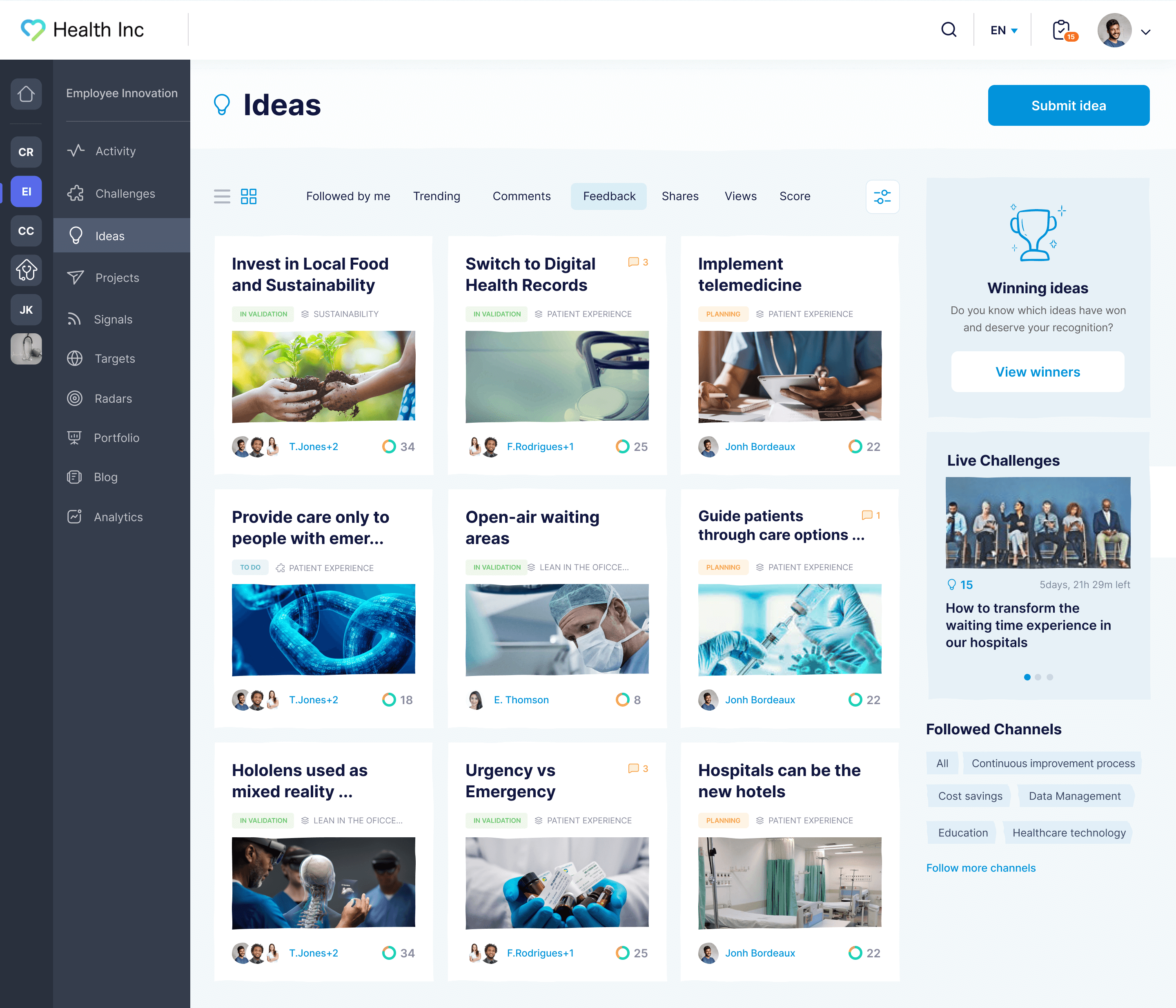
The author's colleagues can view the idea and are encouraged to use their expertise to consider its practicality, potential impact, and risks. They can provide actionable feedback by commenting on the idea, highlighting weaknesses, and proposing solutions.
The idea author is notified of this feedback and can collaborate with colleagues inside InnovationCast to refine the idea.
All messages, comments, suggestions, video calls, and other media shared between authors and colleagues are stored inside the idea thread. This makes it easy to go back and find important discussions and media that shaped the idea. You don’t have to search for Zoom calls, email threads, or Slack messages.
3. Idea Evaluation and Prioritization
After ideas are submitted and refined, they’re ready for evaluation.
Idea evaluators, who are subject matter experts in the field most relevant to the idea, will review the evidence each author provided in their pitch. They then score and prioritize ideas based on demand, feasibility, potential impact, and alignment with company goals.
Ideas that meet the pre-defined minimum score are considered for implementation, while those that underperform are either sent back to the author for further refinement or discarded if the deficiencies are too significant to resolve.
For revolutionary ideas, evaluators typically forgo traditional scorecard evaluations, as these ideas are entirely new and the necessary data for scoring them doesn’t exist. Instead, these ideas are moved directly into the validation phase, where experiments, prototypes, and market tests help determine their feasibility and potential impact. (More on validation below.)
Many companies make the mistake of sending ideas to evaluators without providing clear guidance on how to evaluate them — what criteria to prioritize, which factors to consider, and how to score or compare different proposals.
While evaluators may have the expertise to determine whether an idea is worth pursuing, they may each apply different standards, leading to subjective assessments and difficulty reaching a consensus. Without a standardized framework, strong ideas may be rejected due to unclear expectations, while weaker ideas may slip through because they align with the evaluator’s personal preferences rather than the company’s goals.
To ensure that all ideas are evaluated fairly, we urge innovation managers to establish scoring systems, frameworks, and guidance for evaluators.
Read more: Best Practices to Evaluate Innovation Ideas
InnovationCast Includes Scoring Systems and Evaluation Models Tailored to Different Types of Ideas
Innovation managers can assign evaluators to different Innovation Challenges.
Evaluators are notified when an idea is received. They can log into InnovationCast and see all the ideas they’re responsible for.
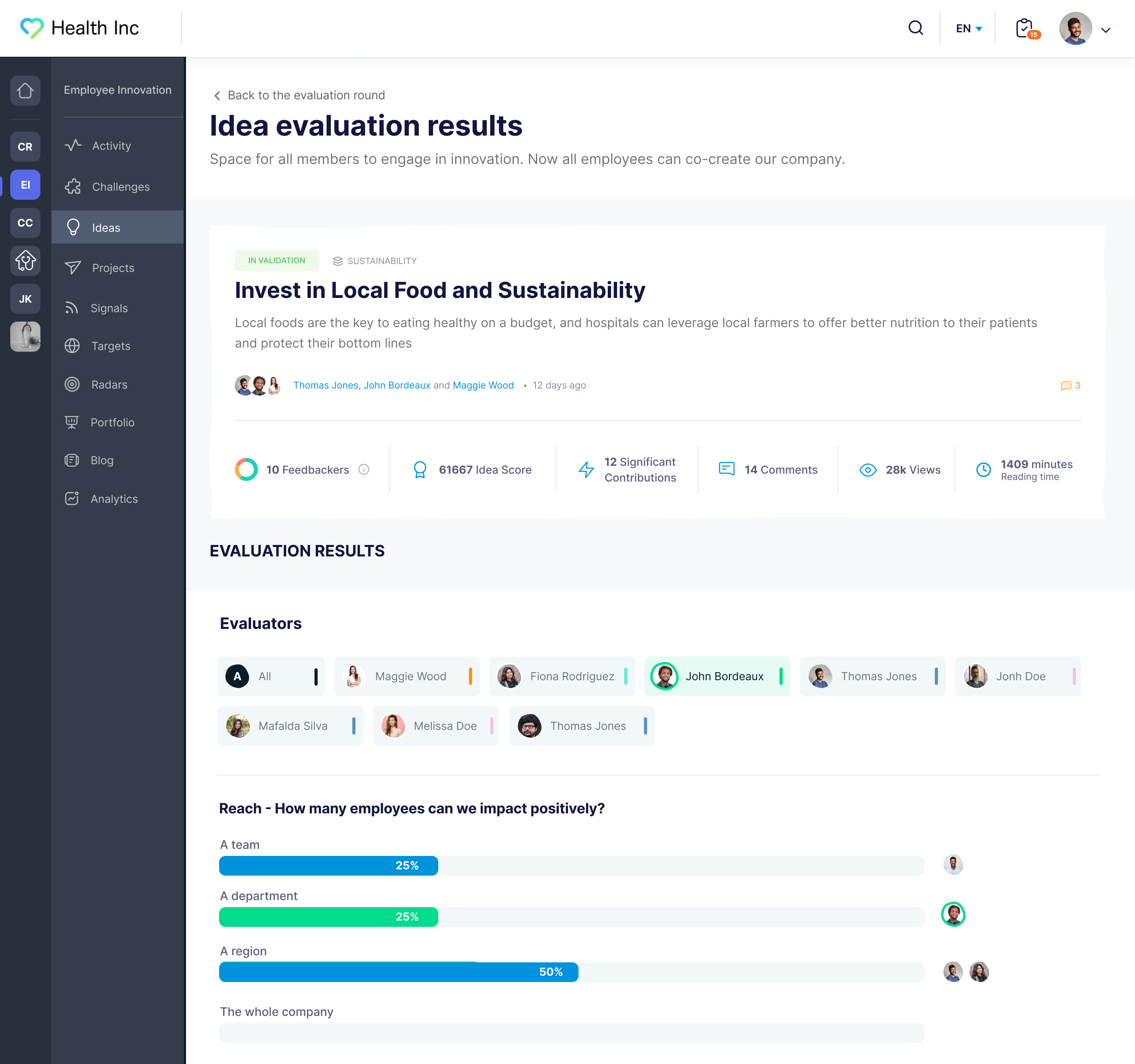
They can access scoring systems and evaluation models that walk them through how to evaluate the idea, i.e., what data to consider, key risks to assess, and criteria for determining feasibility and impact. They can then use one of our scoring systems to score ideas.
If the evaluator needs more information or wants to talk to the author, they can reach out inside InnovationCast, where everything is recorded and centralized.
Idea contributors can see how well their idea performs against the evaluation criteria. This transparency tells the authors the company is actually working on their idea — it isn’t left untouched.
4. Idea Validation and Incubation
Ideas with significant risk and uncertainty around whether they’ll be successful, such as ideas for new offerings, startup partnerships, or aimed at exploring new markets or value propositions, are usually put through validation, also known as incubation.
Validation is necessary because there’s no objective evidence backing the idea. These types of ideas are entirely new ventures, so companies need to gather evidence and knowledge that supports the idea and reduces risk and uncertainty.
Stakeholders will assemble a validation or innovation team and discuss with them the assumptions or hypotheses that must hold true for the idea to succeed. This is usually related to demand, technical feasibility, and financial viability. Do enough users want this? Can it be produced at a sustainable cost? Will it generate sufficient revenue to justify further investment?
These innovation teams operate like entrepreneurs within the company, working to reduce risk and demonstrate that an idea is viable and worth the company’s investment in implementation.
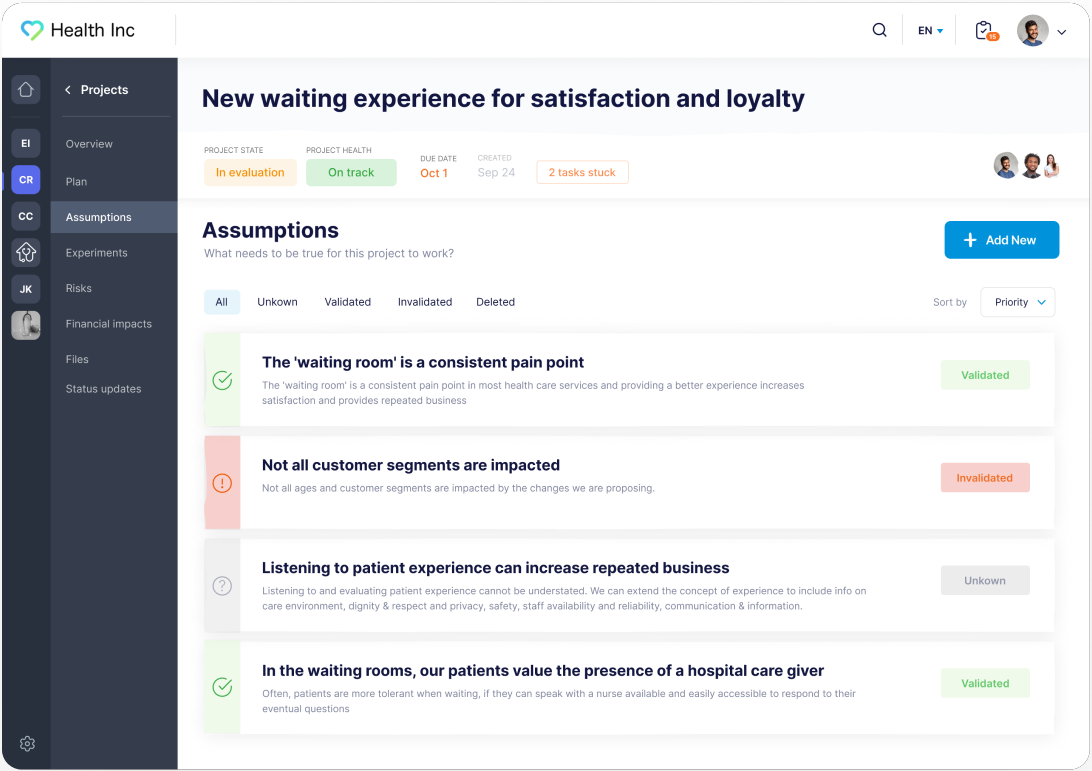
Stakeholders will assign a budget for the innovation team to design experiments and test assumptions before committing further resources. They usually start by validating the highest-risk, highest-uncertainty assumptions and move from there. The output of those experiments is knowledge that either validates or invalidates assumptions.
There are two key mistakes we see companies make when setting up incubation programs that jeopardize their innovation efforts:
They provide financial resources to the entire innovation project upfront.
They don’t give teams the necessary support to validate their idea.
Avoid Funding Validation Projects Upfront — Use Metered Funding Instead
When funding validation projects, many companies mistakenly fund the entire project upfront.
This is a problem because it encourages teams to design costly, complex experiments rather than embracing an innovation mindset focused on finding the most cost-effective ways to validate assumptions. As a result, companies limit the number of ideas they can fund.
We advise companies to use Metered Funding.
Metered Funding is a venture capital funding approach that involves releasing resources in stages. A small amount of funding is given to validate the first couple of assumptions. Once those assumptions are validated, the next round of funding is unlocked. This funding cycle continues until all assumptions are valid or the team runs into invalid assumptions; at this point, the idea is cut loose.
This funding approach has two main benefits:
Companies can fund more projects: Metered Funding allows companies to distribute smaller amounts of funding across multiple projects rather than allocating a large budget to just a few high-risk ideas. By funding a broader range of ideas, companies increase their chances of discovering revolutionary innovations.
The best projects receive the most support: As projects progress through validation and demonstrate real potential, they naturally attract more funding and resources. This merit-based system ensures that the most promising ideas receive the necessary support while weaker ideas are identified early and phased out.
Establish the Workflows to Validate Ideas
Another mistake companies make is not giving innovation teams the necessary support and training to validate ideas.
Without proper guidance, teams may struggle to identify key assumptions, design meaningful experiments, or analyze results accurately. This can lead to flawed validation processes, where promising ideas are dismissed prematurely.
To avoid this, companies should equip innovation teams with structured workflows that guide them through validation.
We designed InnovationCast with these workflows. They guide teams through every stage of the innovation process — from idea evaluation to validation and full-scale implementation.
We have workflows for new business model ideas, technological innovation ideas, digital transformation ideas, sustainability ideas, and more. These workflows are based on methodologies such as Lean Startup, Customer Development, and Jobs to be Done.
Depending on the idea, they usually go through a few key steps:
Experimentation: We show teams how to map out key assumptions, reduce uncertainty, and gather real-world insights.
Pilot testing: We show teams how to launch controlled trials to measure impact before full deployment.
Implementation and scaling: We show teams how to turn validated ideas into shippable solutions that drive business value.
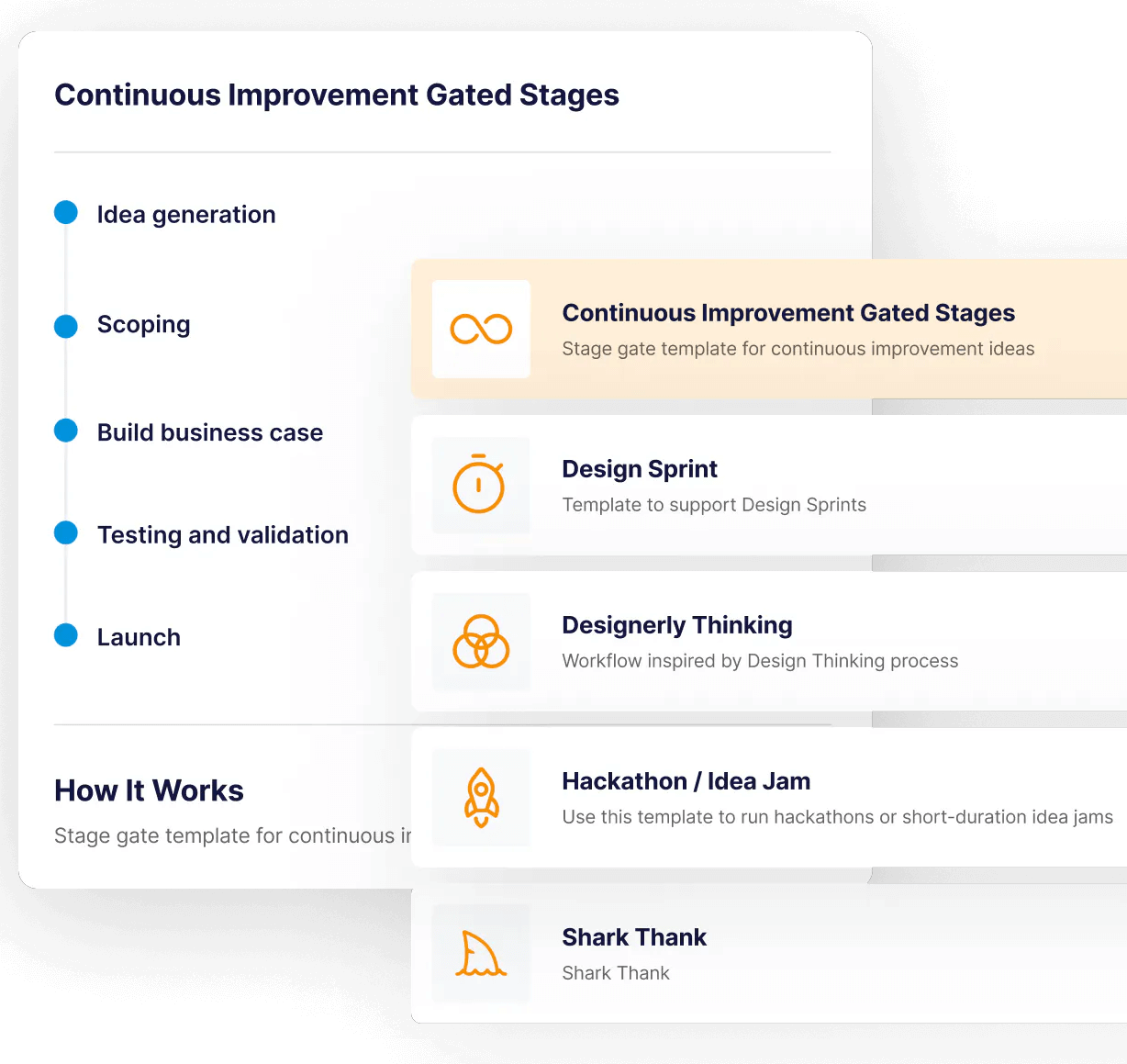
By providing a structured validation process rather than leaving teams to operate in an ad hoc manner, companies achieve higher project success rates — driving innovation and maintaining their competitive advantage.
5. Implementation
Once an innovation team has conducted learnings and reduced risk and uncertainty around the idea, stakeholders fund the full project.
In larger companies, this implementation phase of the innovation program isn’t the responsibility of the innovation team or the innovation department. Most companies have established project management offices responsible for launching new products. These offices consist of project managers, scrum masters, and project coordinators who establish tasks to complete and assign those to employees working in the project management office.
For example, if an employee had an idea for a new coffee-flavored yogurt that passed all validation stages, the project management office would establish internal processes for manufacturing the new yogurt, sourcing suppliers, coordinating distribution channels, and collaborating with the marketing team to develop marketing strategies.
Read more: How to Develop an Innovation Process to Launch New Ideas
Establish an Effective Innovation Ecosystem within Your Organization Using InnovationCast
Book a quick call to learn more about how InnovationCast can help your company implement the processes and best practices mentioned above.
FAQ
What Is a Corporate Innovation Program?
A corporate innovation program is a structured initiative designed to collect, evaluate, and develop ideas into impactful solutions. These programs help organizations drive business growth by fostering continuous improvements, disruptive innovations, and cross-functional collaboration while ensuring that promising ideas are systematically refined and implemented.
What Is the 70-20-10 Rule for Innovation?
The 70-20-10 rule suggests that companies should allocate 70% of their innovation efforts to core improvements, 20% to adjacent opportunities, and 10% to disruptive breakthroughs. This balanced approach helps businesses maintain stability while investing in future growth and exploring high-risk, high-reward innovations. Mileage may vary for different organizations, but any effective innovation program needs to explicitly consider all types of innovation: core improvements, adjacent opportunities, and disruptive breakthroughs.
How Do You Create a Corporate Innovation Program?
To build an effective corporate innovation program, organizations must define clear objectives and innovation intent, communicate their innovation strategy, secure leadership support, and establish structured processes for evaluating and validating ideas. Providing dedicated funding, employee engagement incentives, and external collaboration opportunities further enhances the program’s success.
How Do You Encourage Employees to Participate in Corporate Innovation?
Creating a culture of innovation requires support from business leaders, incentives, and clear communication. Companies should recognize and reward contributions, provide dedicated time for innovation, and implement structured processes that make it easy for employees to submit, develop, and refine ideas.
What Role Does External Innovation Play in Corporate Innovation Programs?
External innovation expands a company’s capabilities by sourcing ideas from startups, academia, and industry experts. By looking beyond internal resources, organizations can access fresh perspectives, cutting-edge technologies, and strategic partnerships that accelerate problem-solving.

